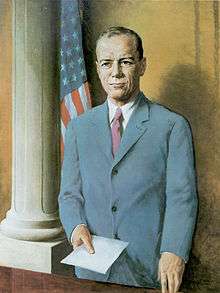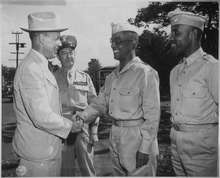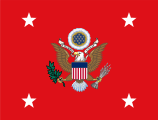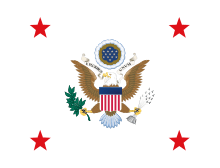Robert P. Patterson
| Robert P. Patterson | |
|---|---|
 | |
| 55th United States Secretary of War | |
|
In office September 27, 1945 – July 18, 1947 | |
| President | Harry S. Truman |
| Preceded by | Henry L. Stimson |
| Succeeded by | Kenneth C. Royall |
| Judge of the United States Court of Appeals for the Second Circuit | |
|
In office March 21, 1939 – July 30, 1940 | |
| Appointed by | Franklin D. Roosevelt |
| Preceded by | Martin Thomas Manton |
| Succeeded by | Jerome Frank |
| Judge of the United States District Court for the Southern District of New York | |
|
In office May 13, 1930 – March 22, 1939 | |
| Appointed by | Herbert Hoover |
| Preceded by | Thomas D. Thacher |
| Succeeded by | Simon H. Rifkind |
| Personal details | |
| Born |
Robert Porter Patterson February 12, 1891 Glens Falls, New York, U.S. |
| Died |
January 22, 1952 (aged 60) Newark Liberty International Airport Newark, New Jersey, U.S. |
| Resting place | Arlington National Cemetery in Arlington, Virginia, U.S. |
| Political party | Republican |
| Spouse(s) |
Margaret Tarleton Winchester Patterson (m. 1920 - 1952, his death) |
| Children |
Robert P. Patterson, Jr. Aileen W. Patterson Susan Patterson Hand Virginia D. Patterson |
| Parents |
Charles Robert Patterson Lodice Edna Porter Patterson |
| Alma mater |
Union College Harvard Law School |
| Profession | Government |
| Religion | Presbyterian |
| Awards | Distinguished Service Cross |
| Military service | |
| Service/branch | United States Army |
| Rank | Major |
| Battles/wars | World War I |
Robert Porter Patterson, Sr. (February 12, 1891 – January 22, 1952) was the United States Under Secretary of War under President Franklin Roosevelt and the United States Secretary of War under President Harry S. Truman from September 27, 1945 to July 18, 1947.
Background
Patterson was born in Glens Falls, New York on February 12, 1891, the son of Lodice Edna (née Porter) and Charles Robert Patterson. He graduated from Union College and Harvard Law School.
Career
Patterson practiced law in New York City.
He served in the United States Army during World War I, reaching the rank of major, and received the Distinguished Service Cross for heroism in France.
Government
In 1930, President Herbert Hoover appointed Patterson as a judge of the United States District Court for the Southern District of New York.
In 1939, President Franklin D. Roosevelt promoted Patterson to the United States Court of Appeals for the Second Circuit, where he sat with judges Learned Hand, Augustus Hand, and Thomas Walter Swan.
In 1940, after 15 months of service on the Second Circuit, Patterson left the bench to join the War Department. After a few months as Assistant Secretary of War, President Roosevelt promoted Patterson to Undersecretary of War late in 1940. He was instrumental in the mobilization of the armed forces preparatory to and during World War II.[1]

President Harry S. Truman appointed Patterson as Secretary of War in 1945. Truman initially was set to offer Patterson a seat on the Supreme Court which was left vacant by Justice Owen J. Roberts, however, with the resignation of Henry L. Stimson, Patterson instead became the Secretary of War.[2] Patterson advocated unifying the armed services (army and navy) and having a single chief of staff. Steps to this effect were begun by the National Security Act of 1947 and revised several times, finally by the Goldwater-Nichols Act of 1986. Patterson participated in the desegregation of the armed forces, specifically during late stages of World War II with regard to creating an African-American fighter group, known now as the Tuskeegee airmen.
Private career
On July 18, 1947, Patterson stepped down as judge and returned to his law practice in 1947. (President Truman reportedly had offered to reappoint him to his former judgeship on the Second Circuit, but Patterson had declined.) The firm, which continues as a preeminent law firm in New York City, still carries his name, Patterson Belknap Webb & Tyler.
He later served as the president of the Association of the Bar of the City of New York, and the president of the Council on Foreign Relations.
Personal and death
On January 3, 1920, Patterson married the former Margaret Tarleton Winchester (March 12, 1897 - March 28, 1988); they had four children: Robert P. Patterson, Jr., Aileen W. Patterson, Susan H. Patterson and Virginia D. Patterson.
Patterson housed William J. Marbury, Jr., at his Georgetown home. After the war, he recommended Marbury to succeed him at the United Nations; upon advice from Alger Hiss, Marbury declined. (Marbury soon thereafter represented Hiss in his slander case against Whittaker Chambers.)[3]
He died on January 22, 1952, returning from meeting a client, onboard American Airlines Flight 6780 which crashed on the approach to Newark Liberty International Airport in Elizabeth, New Jersey; he was age 60.
Son Robert P. Patterson, Jr. was a federal judge in the Southern District of New York, until his death in 2015.
Works
In 2012, the University of Tennessee Press published The World War I Memoirs of Robert P. Patterson: A Captain in the Great War, edited by J. Garry Clifford.
In 2014, the University of Tennessee Press published his previously unpublished 1947 memoir Arming the Nation for War, with a foreword by Robert M. Morgenthau, former Manhattan district attorney, and edited by Brian Waddell, associate professor at the University of Connecticut.
- The World War I Memoirs of Robert P. Patterson: A Captain in the Great War (2012)
- Arming the Nation for War: Mobilization, Supply, and the American War Effort in World War II (2014)
References
- ↑ Herman, Arthur. Fredom's Forge: How American Business Produced Victory in World War II, pp. 157, 161, 165-6, 175, 236, 238-9, 284-5, 288, Random House, New York, NY, 2012. ISBN 978-1-4000-6964-4.
- ↑ Eiler, op. cit. p 443-444
- ↑ Marbury, Jr., William L. (1981). "The Hiss-Chambers Libel Suit" (PDF). Maryland Historical Magazine. 76 (1): 74 (Georgetown), 76 (UN job). Retrieved 23 November 2016.
- Eiler, Keith. (1997) Mobilizing America: Robert P. Patterson and the War Effort, 1940-1945. Cornell University Press.
External links
- Robert P. Patterson at the Biographical Directory of Federal Judges, a public domain publication of the Federal Judicial Center.

| Wikimedia Commons has media related to Robert Porter Patterson. |
| Political offices | ||
|---|---|---|
| Preceded by Thomas D. Thacher |
Judge of the United States District Court for the Southern District of New York 1930–1939 |
Succeeded by Simon H. Rifkind |
| Preceded by Martin Thomas Manton |
Judge of the United States Court of Appeals for the Second Circuit 1939–1940 |
Succeeded by Jerome Frank |
| Preceded by Henry L. Stimson |
U.S. Secretary of War Served under: Harry S. Truman 1945–1947 |
Succeeded by Kenneth C. Royall |
| Preceded by New office |
United States Under Secretary of War 1940–1945 |
Succeeded by Kenneth C. Royall |


